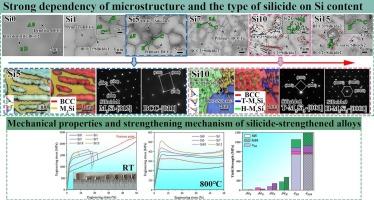揭示了硅化物强化(TiZrHfNb)100- x6 (x = 0、1、5、7、10和15)难熔高熵合金的显微组织演变和力学性能
IF 7.9
2区 材料科学
Q1 MATERIALS SCIENCE, MULTIDISCIPLINARY
引用次数: 0
摘要
选用延展性强的TiZrHfNb耐火高熵合金,形成硅化物强化(TiZrHfNb)100- x6 (x = 0、1、5、7、10和15)。系统地研究了Si含量对合金组织和力学性能的影响。在Si含量为1% ~ 15%的范围内,凝固组织和硅化物类型对Si含量的依赖性较强,前者由亚共晶组织转变为过共晶组织,后者由m3si型硅化物转变为四方- m5si3型硅化物,最后转变为四方- m5si3型硅化物和六方- m5si3型硅化物并存。硅化相的形成提高了TiZrHfNb原型合金在室温和高温下的强度,在800℃时,添加15% Si的TiZrHfNb原型合金的峰值抗压强度从221.3 MPa显著提高到511.59 MPa。结果表明,由相界位错堆积引起的异质变形强化是合金强度提高的主要原因。在热变形过程中,由于动态恢复和动态再结晶的存在,流变应力在达到峰值后开始减小,且在Si含量较高时更为明显。本文章由计算机程序翻译,如有差异,请以英文原文为准。

Unveiling microstructure evolution and mechanical properties of silicide-strengthened (TiZrHfNb)100-xSix (x = 0, 1, 5, 7, 10 and 15) refractory high-entropy alloys
The ductile TiZrHfNb refractory high-entropy alloy is selected to form silicide-strengthened (TiZrHfNb)100-xSix (x = 0, 1, 5, 7, 10 and 15, in at. %) alloys, and the influence of Si content on the microstructure and mechanical properties was systematically investigated. The solidification microstructure and the type of silicide show strong dependence on Si content from 1 % to 15 %, with the former changing from hypoeutectic to hypereutectic structure, and the latter evolving from M3Si-type to tetragonal-M5Si3-type silicide, and finally to the co-existence of both tetragonal- and hexagonal- M5Si3-type silicide. The formation of silicide phase enhances the strength both at the ambient and elevated temperatures, and a significant improvement of peak compressive strength from 221.3 MPa to 511.59 MPa at 800℃ was obtained after alloying 15 % Si to the prototype TiZrHfNb alloy. It was found that heterodeformation-induced strengthening, resulting from dislocation pile-ups at phase boundaries, was responsible for the enhancement in the strength. During hot deformation, the flow stress begins to decrease after reaching the peak value due to the presence of the dynamic recovery and dynamic recrystallization, which becomes more pronounced at higher Si content.
求助全文
通过发布文献求助,成功后即可免费获取论文全文。
去求助
来源期刊

Materials & Design
Engineering-Mechanical Engineering
CiteScore
14.30
自引率
7.10%
发文量
1028
审稿时长
85 days
期刊介绍:
Materials and Design is a multi-disciplinary journal that publishes original research reports, review articles, and express communications. The journal focuses on studying the structure and properties of inorganic and organic materials, advancements in synthesis, processing, characterization, and testing, the design of materials and engineering systems, and their applications in technology. It aims to bring together various aspects of materials science, engineering, physics, and chemistry.
The journal explores themes ranging from materials to design and aims to reveal the connections between natural and artificial materials, as well as experiment and modeling. Manuscripts submitted to Materials and Design should contain elements of discovery and surprise, as they often contribute new insights into the architecture and function of matter.
 求助内容:
求助内容: 应助结果提醒方式:
应助结果提醒方式:


